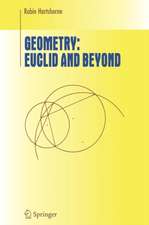Redefining Geometrical Exactness: Descartes’ Transformation of the Early Modern Concept of Construction: Sources and Studies in the History of Mathematics and Physical Sciences
Autor Henk J.M. Bosen Limba Engleză Paperback – 21 oct 2012
Din seria Sources and Studies in the History of Mathematics and Physical Sciences
- 20%
 Preț: 756.13 lei
Preț: 756.13 lei - 18%
 Preț: 907.11 lei
Preț: 907.11 lei - 15%
 Preț: 667.86 lei
Preț: 667.86 lei - 18%
 Preț: 1434.29 lei
Preț: 1434.29 lei -
 Preț: 387.75 lei
Preț: 387.75 lei - 15%
 Preț: 638.57 lei
Preț: 638.57 lei - 18%
 Preț: 896.70 lei
Preț: 896.70 lei - 15%
 Preț: 643.65 lei
Preț: 643.65 lei - 18%
 Preț: 916.25 lei
Preț: 916.25 lei - 18%
 Preț: 1124.92 lei
Preț: 1124.92 lei - 18%
 Preț: 963.29 lei
Preț: 963.29 lei - 15%
 Preț: 652.31 lei
Preț: 652.31 lei - 18%
 Preț: 1244.89 lei
Preț: 1244.89 lei - 23%
 Preț: 686.57 lei
Preț: 686.57 lei - 15%
 Preț: 649.71 lei
Preț: 649.71 lei -
 Preț: 390.25 lei
Preț: 390.25 lei - 15%
 Preț: 644.18 lei
Preț: 644.18 lei - 15%
 Preț: 580.17 lei
Preț: 580.17 lei - 18%
 Preț: 1123.35 lei
Preț: 1123.35 lei - 15%
 Preț: 641.03 lei
Preț: 641.03 lei - 15%
 Preț: 581.14 lei
Preț: 581.14 lei - 18%
 Preț: 2119.49 lei
Preț: 2119.49 lei - 24%
 Preț: 860.16 lei
Preț: 860.16 lei - 15%
 Preț: 645.14 lei
Preț: 645.14 lei -
 Preț: 384.48 lei
Preț: 384.48 lei - 18%
 Preț: 1410.63 lei
Preț: 1410.63 lei - 18%
 Preț: 969.28 lei
Preț: 969.28 lei - 15%
 Preț: 642.03 lei
Preț: 642.03 lei - 18%
 Preț: 1113.71 lei
Preț: 1113.71 lei - 15%
 Preț: 662.16 lei
Preț: 662.16 lei - 18%
 Preț: 963.29 lei
Preț: 963.29 lei - 15%
 Preț: 647.59 lei
Preț: 647.59 lei -
 Preț: 395.63 lei
Preț: 395.63 lei - 18%
 Preț: 941.50 lei
Preț: 941.50 lei - 15%
 Preț: 709.56 lei
Preț: 709.56 lei - 18%
 Preț: 901.26 lei
Preț: 901.26 lei - 15%
 Preț: 695.53 lei
Preț: 695.53 lei - 24%
 Preț: 1294.90 lei
Preț: 1294.90 lei
Preț: 796.31 lei
Preț vechi: 971.10 lei
-18% Nou
Puncte Express: 1194
Preț estimativ în valută:
152.37€ • 159.52$ • 126.08£
152.37€ • 159.52$ • 126.08£
Carte tipărită la comandă
Livrare economică 05-19 aprilie
Preluare comenzi: 021 569.72.76
Specificații
ISBN-13: 9781461265214
ISBN-10: 1461265215
Pagini: 496
Ilustrații: XIX, 472 p.
Dimensiuni: 178 x 254 x 30 mm
Greutate: 0.85 kg
Ediția:Softcover reprint of the original 1st ed. 2001
Editura: Springer
Colecția Springer
Seria Sources and Studies in the History of Mathematics and Physical Sciences
Locul publicării:New York, NY, United States
ISBN-10: 1461265215
Pagini: 496
Ilustrații: XIX, 472 p.
Dimensiuni: 178 x 254 x 30 mm
Greutate: 0.85 kg
Ediția:Softcover reprint of the original 1st ed. 2001
Editura: Springer
Colecția Springer
Seria Sources and Studies in the History of Mathematics and Physical Sciences
Locul publicării:New York, NY, United States
Public țintă
ResearchCuprins
1 General introduction.- 2 The legitimation of geometrical procedures before 1590.- 3 1588: Pappus’ “Collection”.- 4 The early modern tradition of geometrical problem solving; survey and examples.- 5 Early modern methods of analysis.- 6 Arithmetic, geometry, algebra, and analysis.- 8 Using algebra — Viète’s analysis.- 9 Clavius.- 10 Viète.- 11 Kepler.- 12 Molther.- 13 Fermat.- 14 Geometrical problem solving —the state of the art c. 1635.- 15 Introduction to Part II.- 16 Construction and the interpretation of exactness in Descartes’ studies of c. 1619.- 17 Descartes’ general construction of solid problems c. 1625.- 18 Problem solving and construction in the “Rules for the direction of the mind” (c. 1628).- 19 Descartes’ first studies of Pappus’ problem (early 1632).- 20 The Geometry, introduction and survey.- 21 Algebraic operations in geometry.- 22 The use of algebra in solving plane and indeterminate problems.- 23 Descartes’ solution of Pappus’ problem.- 24 Curves and the demarcationof geometry in the Geometry.- 25 Simplicity and the classification of curves.- 26 The canon of geometrical construction.- 27 The theory of equations in the Geometry.- 28 Conclusion of Part II.- 29 Epilogue.- List of problems.- Name Index.
Recenzii
"This is a brilliant book and the most satisfactory account of Descartes' mathematical career that I have come across. Although the author does not claim to provide an exhaustive study of Descartes' geometry, he illuminates it in an original way by focusing on the conception and practice of construction. The book covers essentially the period from 1588, when Commandino's Latin translation of the surviving books of Pappus' Collections appeared, to 1650 when Descartes met his untimely death in Sweden. Bos discusses the opinions of five mathematicians who stated their position on construction explicitly, namely Clavius, Viète, Kepler, Molther and Fermat. He then sketches out the background to Descartes' program for restructuring the art of geometrical problem solving that led to the Geometry of 1637, a work that he analyses in detail. The concluding two chapters summarise the dynamics of Descartes' geometrical thinking and sketch the development that followed upon Descartes' achievement."--MATHEMATICAL REVIEWS













